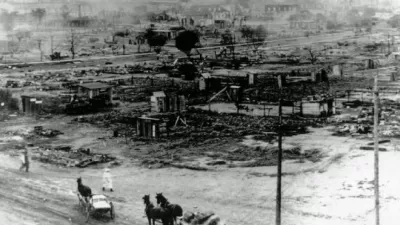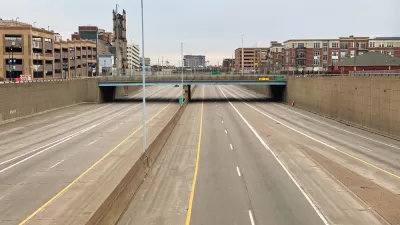After the Tulsa Race Massacre, Greenwood rebuilt strong. Then came "urban renewal."

The Tulsa Daily World’s June 2, 1921 morning edition headline read: “Dead Estimated at 100: City is Quiet. $2000 to Start Fund for Relief. Negros Gladly Accept Guards. 5,000 Negro Refugees Guarded in Camp at County Fairgrounds.”
Fewer than 24 hours after Ku Klux Klan leaders — along with the Tulsa Police Department and the Oklahoma National Guard — carried out the nation’s deadliest and most destructive massacre, Tulsa’s paper of record was already at work crafting a narrative that would shape the way that the city would think about the massacre in Greenwood for the next 100 years.
Thanks to recent scholarship and pop culture depictions of the massacre in Greenwood, more and more Americans are coming to know the story of the Tulsa Race Massacre that destroyed Black Wall Street. But the common narrative — that the massacre destroyed the neighborhood and it never recovered — is incorrect. In fact, Greenwood’s resilient residents rebuilt their community almost immediately after the massacre — in defiance of hastily-enacted racist zoning codes — giving rise to the popular use of the neighborhood’s moniker of Black Wall Street after, not before, the massacre. And while a price cannot be put on the 300 lives lost, the violence that really destroyed Black Wall Street wasn’t physical, but structural.
FULL STORY: Black Wall Street's Second Destruction

Alabama: Trump Terminates Settlements for Black Communities Harmed By Raw Sewage
Trump deemed the landmark civil rights agreement “illegal DEI and environmental justice policy.”

Study: Maui’s Plan to Convert Vacation Rentals to Long-Term Housing Could Cause Nearly $1 Billion Economic Loss
The plan would reduce visitor accommodation by 25% resulting in 1,900 jobs lost.

Why Should We Subsidize Public Transportation?
Many public transit agencies face financial stress due to rising costs, declining fare revenue, and declining subsidies. Transit advocates must provide a strong business case for increasing public transit funding.

Paris Bike Boom Leads to Steep Drop in Air Pollution
The French city’s air quality has improved dramatically in the past 20 years, coinciding with a growth in cycling.

Why Housing Costs More to Build in California Than in Texas
Hard costs like labor and materials combined with ‘soft’ costs such as permitting make building in the San Francisco Bay Area almost three times as costly as in Texas cities.

San Diego County Sees a Rise in Urban Coyotes
San Diego County experiences a rise in urban coyotes, as sightings become prevalent throughout its urban neighbourhoods and surrounding areas.
Urban Design for Planners 1: Software Tools
This six-course series explores essential urban design concepts using open source software and equips planners with the tools they need to participate fully in the urban design process.
Planning for Universal Design
Learn the tools for implementing Universal Design in planning regulations.
Smith Gee Studio
Alamo Area Metropolitan Planning Organization
City of Santa Clarita
Institute for Housing and Urban Development Studies (IHS)
City of Grandview
Harvard GSD Executive Education
Toledo-Lucas County Plan Commissions
Salt Lake City
NYU Wagner Graduate School of Public Service





























